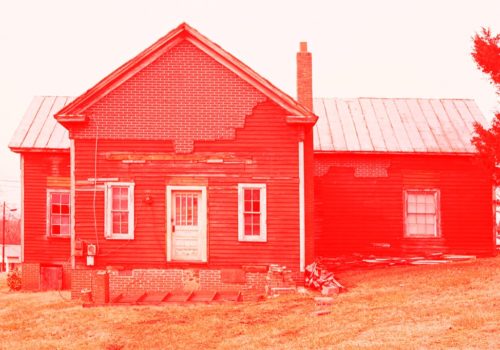When photographers go looking for America, they tend to seek the open road. The inclination make sense. America’s vastness and diversity are defining characteristics. What better way to witness it than in wide sweeps, from the window of a car? Walker Evans pioneered the American road trip photography genre with his 1938 book and exhibit, “American Photographs.” The same approach worked for Robert Frank in his 1959 book, The Americans. Henri Cartier-Bresson made similar journeys.
When French photographer Sylvain Couzinet-Jacques won the inaugural Immersion photography commission from the Foundation d’entreprise Hermes and the Aperture Foundation—a French and American creative exchange program— he, too, wanted to make some kind of sense of America. But he decided to do it by staying put. He would, he decided, let the United States come to him. So he decided to buy a house.
In April 2015, he found one, an abandoned, wooden structure in the city of Eden, North Carolina known as the Little Red Schoolhouse. It was built in 1884— the same year, Couzinet-Jacques notes, that Kodack patented the “modern form of photographic film”— and once housed the oldest public school in the city. Couzinet-Jacques bought it for $1,000. Over the last two years, the house has become both inspiration and material for his artistic practice. Now, in an exhibition at Aperture Gallery, he is showing the fruits of that labor, a body of work meant, according to Aperture, to “grapple with the often contradictory themes of utopia and home, the inevitable gaps between representation and reality, and the work of art as a means of re-enchantment.” As Couzinet-Jacques himself wrote in an accompanying wall text, the house could be seen as “the singular space for many possible stories.”
“It is always surprising how entire worlds can nestle in the details, how territories that seem at first to be limited turn out to be vast expanses to explore. By reducing my practice to the space of the house, I opened up a complex and infinite world,” Couzinet-Jacques wrote.
The exhibit is nothing if not expansive. At Aperture, you’ll find Polaroids, video, archival photographs, found objects, historical documents, and sculpture. In addition to Couzinet-Jacques’ photographs, you’ll also find contributions from a group of artists and creatives including Amelia Rina, Fred Cave, Thomas Hauser, Ugo Schiavi, Pat McCarthy and Jesse Hoyle. Some of the objects are housed in a variety of wood and glass constructions that will eventually be repurposed to restore the dilapidated house. Elsewhere in the exhibition, you’ll find parts of the actual building, including, most prominently, a piece of the back porch, which has been mounted so that it’s standing upright.
What results is a textured and loving portrait that, nonetheless, might leave viewers wondering what exactly is so special about the Little Red Schoolhouse. Rather than a vehicle for looking outward, Eden gets trapped in a tunnel of looking ever inward with scant revelations to show for it. We see the house in obsessive, all but microscopic detail, but the crucial link between the minutia and something larger is elusive.
Couzinet-Jacques’ is clearly fascinated with the home, and as with any earnestly-felt interest, it can lead to the mundane. One special, private enclave in the gallery exists exclusively for visitors to thumb through a copy of Eden, a 992-page book comprised of black-and-white scans Couzinet-Jacques made of nearly the entire home. While it’s an impressive conceptual feat, viewers will find little reward in perusing the hundreds of repetitive images. Other photos in the exhibit, meanwhile, attempt to create a sense of magic in a place named for a biblical paradise, but Couzinet-Jacques relies too heavily on simplistic color overlays. Splashes of red, green and blue can only do so much to mask what’s essentially drab.
Eden is a work in progress, and in the future Couzinet-Jacques imagines he will use the house as a “walk-in art space, a lab for pictures, screen-printing, and sculpture.” At the moment, Eden strikes primarily as a monument to the past, one that too often resembles the sterile treatment of a moderately interesting local history museum. But if Eden is to seem relevant to a contemporary idea of America, it must have a more tangible and imaginative relationship with what’s to come.
Jordan G. Teicher
Jordan G. Teicher is an American journalist and critic based in Brooklyn, New York.
Sylvain Couzinet-Jacques: Eden
November 17, 2016 – January 19, 2017
Aperture Foundation
4th Floor, 547 W 27th St
New York, NY 10001
USA
















